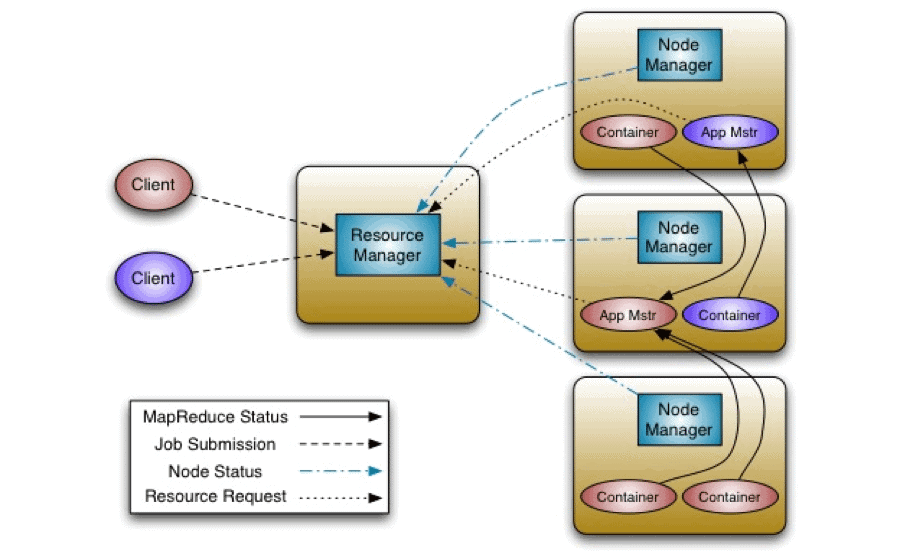

As previously described, YARN is essentially a system for managing distributed applications. It consists of a central ResourceManager, which arbitrates all available cluster resources, and a per-node NodeManager, which takes direction from the ResourceManager and is responsible for managing resources available on a single node.

Resource Manager
In YARN, the ResourceManager is, primarily, a pure scheduler. In essence, it’s strictly limited to arbitrating available resources in the system among the competing applications – a market maker if you will. It optimizes for cluster utilization (keep all resources in use all the time) against various constraints such as capacity guarantees, fairness, and SLAs. To allow for different policy constraints the ResourceManager has a pluggable scheduler that allows for different algorithms such as capacity and fair scheduling to be used as necessary.
ApplicationMaster
Many will draw parallels between YARN and the existing Hadoop MapReduce system (MR1 in Apache Hadoop 1.x). However, the key difference is the new concept of an ApplicationMaster.
The ApplicationMaster is, in effect, an instance of a framework-specific library and is responsible for negotiating resources from the ResourceManager and working with the NodeManager(s) to execute and monitor the containers and their resource consumption. It has the responsibility of negotiating appropriate resource containers from the ResourceManager, tracking their status and monitoring progress.
The ApplicationMaster allows YARN to exhibit the following key characteristics:
It’s a good point to interject some of the key YARN design decisions:
It’s useful to remember that, in reality, every application has its own instance of an ApplicationMaster. However, it’s completely feasible to implement an ApplicationMaster to manage a set of applications (e.g. ApplicationMaster for Pig or Hive to manage a set of MapReduce jobs). Furthermore, this concept has been stretched to manage long-running services which manage their own applications (e.g. launch HBase in YARN via an hypothetical HBaseAppMaster).
Resource Model
YARN supports a very general resource model for applications. An application (via the ApplicationMaster) can request resources with highly specific requirements such as:
ResourceRequest and Container
YARN is designed to allow individual applications (via the ApplicationMaster) to utilize cluster resources in a shared, secure and multi-tenant manner. Also, it remains aware of cluster topology in order to efficiently schedule and optimize data access i.e. reduce data motion for applications to the extent possible.
In order to meet those goals, the central Scheduler (in the ResourceManager) has extensive information about an application’s resource needs, which allows it to make better scheduling decisions across all applications in the cluster. This leads us to the ResourceRequest and the resulting Container.
Essentially an application can ask for specific resource requests via the ApplicationMaster to satisfy its resource needs. The Scheduler responds to a resource request by granting a container, which satisfies the requirements laid out by the ApplicationMaster in the initial ResourceRequest.
Let’s look at the ResourceRequest – it has the following form:
Let’s walk through each component of the ResourceRequest to understand this better.
Now, on to the Container.
Essentially, the Container is the resource allocation, which is the successful result of the ResourceManager granting a specific ResourceRequest. A Container grants rights to an application to use a specific amount of resources (memory, cpu etc.) on a specific host.
The ApplicationMaster has to take the Container and present it to the NodeManager managing the host, on which the container was allocated, to use the resources for launching its tasks. Of course, the Container allocation is verified, in the secure mode, to ensure that ApplicationMaster(s) cannot fake allocations in the cluster.
Container Specification during Container Launch
While a Container, as described above, is merely a right to use a specified amount of resources on a specific machine (NodeManager) in the cluster, the ApplicationMaster has to provide considerably more information to the NodeManager to actually launch the container.
YARN allows applications to launch any process and, unlike existing Hadoop MapReduce in hadoop-1.x (aka MR1), it isn’t limited to Java applications alone.
The YARN Container launch specification API is platform agnostic and contains:
This allows the ApplicationMaster to work with the NodeManager to launch containers ranging from simple shell scripts to C/Java/Python processes on Unix/Windows to full-fledged virtual machines (e.g. KVMs).
YARN – Walkthrough
Armed with the knowledge of the above concepts, it will be useful to sketch how applications conceptually work in YARN.
Application execution consists of the following steps:
Let’s walk through an application execution sequence (steps are illustrated in the diagram):

In our next post in this series we dive more into guts of the YARN system, particularly the ResourceManager – stay tuned!